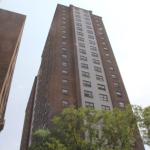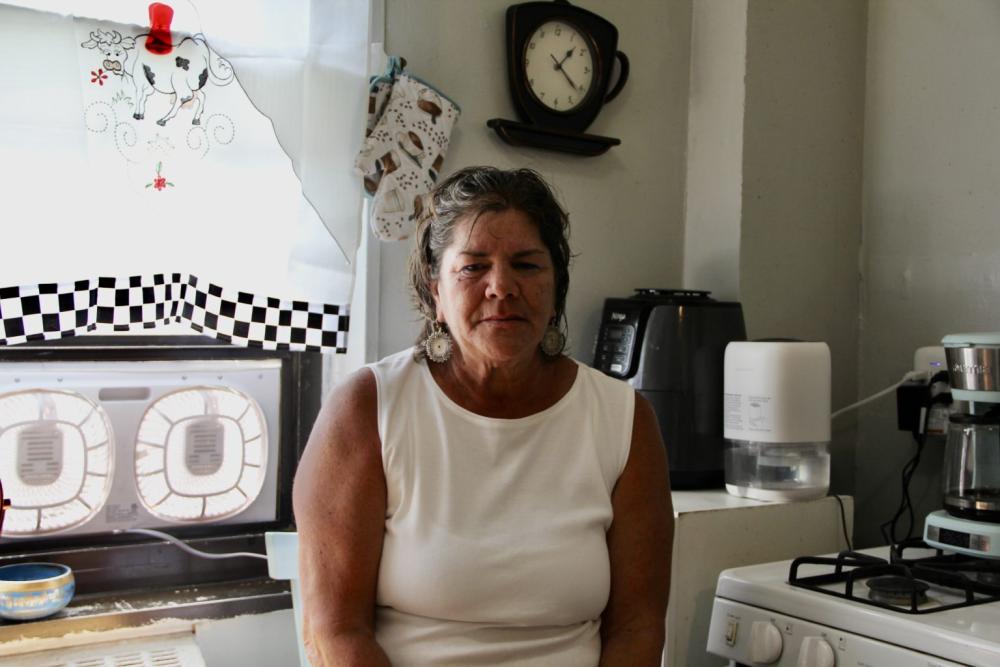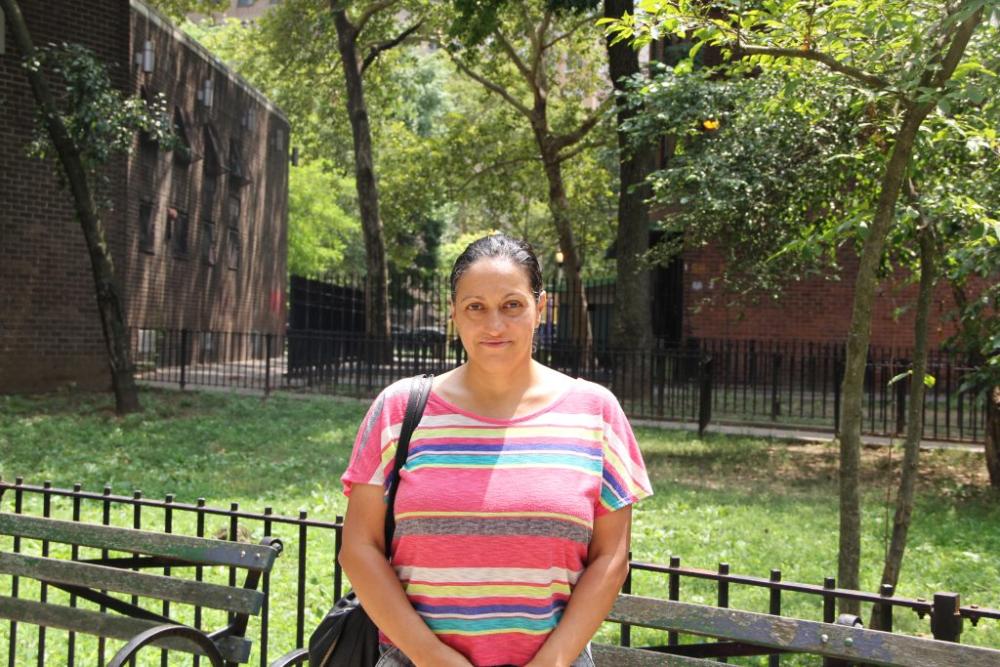NYCHA Residents in Chelsea Resist Demolition Plan That Could Displace Them

Jackie Lara describes coming to the Fulton Houses as “her best Christmas present.” She and her children moved out of a shelter into Fulton Houses, a public-housing development in Manhattan’s Chelsea neighborhood, just after New Years Eve in 2002.
“My application [for public housing] came in after a year and a half of being in the shelter,” Lara says. “And I remember when they called me to come and see this apartment. I planted my seed here. This is my home.”
Celines Mirandas is of the same mind. Her family has lived in the Chelsea-Elliott complex, about half a mile away, since 1975. “My mother is at an age where she gets disoriented a lot. And she doesn’t know which direction to go … but when she’s in her neighborhood, she knows where she’s at. She knows it’s our home.”
Lara and Mirandas, along with the about 4,500 other tenants who live in the Fulton and Chelsea-Elliott Houses, have witnessed the rapid gentrification of their neighborhood over the past two decades. The tenants are now experiencing an even larger change: the recent announcement by New York City Housing Authority (NYCHA) that their buildings will be demolished and rebuilt by The Related Companies and Essence Realty. The mega-project would bring in 2,500 market-rate apartments plus commercial spaces, and the first time mixed-income buildings would be built on NYCHA land.

Jackie Lara

Celines Mirandas
Photos: Owen Schacht
Origins of a Plan
In 2019, NYCHA initiated plans to privatize and demolish the Fulton Houses. The de Blasio administration began working with private developers to raze and rebuild two of the smallest buildings at Fulton Houses, using the program Rental Assistance Demonstration (RAD), which leases NYCHA land to private developers who would make 70% of the new apartments market rate, and 30% affordable housing. The money would allegedly then be used to finance repairs for the rest of Fulton Houses.
That plan, however, was opposed by tenants, who rejected the proposal to tear down two buildings, and instead chose private managers to oversee the renovation. Lara was in the working group of 15 tenants that in 2019 decided against the demolition plan, and has been fighting to stop the demolition ever since. She explained that “as soon as I found out about the demolition [in 2019] I started just looking for people that would help me protest. … And we stopped the demolition for 2019. We went to Community Board 4. We protested.”
As she walks through Chelsea, Mirandas points out the different buildings bordering the NYCHA developments owned by The Related Companies, one of the biggest developers in New York City. Related was also the driving force behind the nearby Hudson Yards luxury development, which opened in 2019 and has received nearly $6 billion in tax breaks and government assistance. The Hudson Yards buildings still sit half-empty.
In early 2023, Related and Essence announced their demolition plans. In a survey distributed in the spring, NYCHA offered residents three options for the future of their homes: new construction with rezoning, new construction without rezoning, or rehabilitation of existing units. The survey did not mention demolition, only new construction, and did not mention the construction of market-rate units on NYCHA land. It also omitted information about temporary relocation. It has been criticized by the Legal Aid Society and Community Services Society, who oppose the demolition on the grounds that it may cause displacement and disagree with the claims that the process has been resident-led.
“We’ve spoken to residents who never saw the survey. The presentation that the survey was based on was misleading.” Alex MaxDougall, a lawyer for Legal Aid Society told The Indypendent. “It didn’t say anything about demolition, didn’t say anything about temporary relocation. It didn’t say anything about the development of 2,500 market-rate apartments.”
MacDougall also pointed out that “Related could never have this land without a public-housing deal. And they’ve been circling this area for a long time.”
According to the anti-demolition group Save Section 9, only 30% of households voted at all in the survey. Among the 30%, 60% voted for “new construction with rezoning for taller buildings in less time.”
When The Indy asked Fulton Houses Tenant Association President Miguel Acevedos about the low turnout, he responded that “the voter turnout on the last mayoral election was 20%. The voter turnout in the last primary that took place in June was 4%. So voting is a problem nationwide.”
A Swiftly-changing Neighborhood
Starting with an influx of Irish immigrants in the mid-19th century, the west end of Chelsea became an industrial zone, with piers jutting into the Hudson River, warehouses and factories, as well as lumberyards, breweries and tenements to house the workers. The east end of Chelsea became a center of American theater. It was also home to the early motion picture industry and to Tin Pan Alley, where much of the popular music of the 1910s and ‘20s was produced. It was a far cry from the expensive retail stores, upscale restaurants and tourist draws like the Highline and Chelsea Market that the area is known for now.
George Weaver, who has lived in Fulton House since 1993, has seen Chelsea’s transformation first hand. “We used to have a lot of mom-and-pop stores in the neighborhood,” he said. “They’re no longer in existence.”
He feels as if he is “absolutely being priced out” of Chelsea, something Lara agrees with. “Chelsea has made it clear they absolutely don’t want us here,” she said.
Weaver, who has a degree in business administration and is pursuing a second degree in public administration, feels like the NYCHA houses are mischaracterized. “A misnomer is that tenants here are not upwardly mobile. A lot of them are college educated. … Some of them are teachers. Some of them are social workers. They live here. And they’ve grown up here. And so why should they have to go anywhere else?”
The Fulton and Chelsea-Elliott demolition would only be the third public housing teardown in NYCHA history. Every anti-demolition tenant and housing advocate The Indy spoke to cited fear of displacement as their primary concern regarding the Chelsea-Elliott and Fulton tear downs. Their fears are not unfounded.
When NYCHA tore down Prospect Plaza, a public-housing project in Brooklyn in the early 2000s, more than 1,000 families were displaced. The same is true for Cabrini Green in Chicago, where more than 80% of public-housing residents never returned after its demolition. In New Orleans after Hurricane Katrina, the City moved to demolish its remaining public housing. Many residents were forced out of the city, into the suburbs and beyond.
NYCHA, Related and Essence insist that mass displacement will not occur. They say that residents will retain lease rights and pay a maximum of 30% of their income toward rent in their new buildings. They estimate that about 6% of tenants, roughly 100 households, will have to move during the rebuilding process. Still, residents are wary. George Weaver said that his biggest fears if demolition goes through are “homelessness and displacement. I mean, people will die.”
The Dilemma
Most residents want repairs. And after decades of disinvestment in public housing by the federal government, some do want demolition.
“I’m disabled and elderly, and I am for the demolition. I want a new apartment,” says Susan Kenney, a resident of Chelsea-Elliott Housing. She cites various repairs NYCHA has failed to keep up with and is confident that she will not be displaced. “The elevators break down. There’s homeless in the building. The door is broken, no intercom system. And we got a lot of drugs in the building.”
“The last thing anybody wants to do is demolition,” says Acevedos. “But the reason for demolition is to create new buildings that won’t deteriorate in the next 10 years.”
Manhattan Borough President Mark Levine also supports the demolition plan. When The Indy asked him if he felt confident that the project would not lead to displacement, he hedged.
“We need to ask more questions about it,” said Levine. “The way it’s been explained so far — and again, we got to ask tough questions — is that they would first build new homes before any building would be demolished. And so that’s a much better model, because you’re not displaced all over New York City.”
When asked about the Legal Aid Society and Community Service Society’s criticism of the plan as not being resident-led, the borough president said he has been in touch with the leadership of Legal Aid Society, and praised them for asking “great questions” about the proposal.
Would people be allowed to remain on the NYCHA campus during the construction process? Would they be able to keep apartments big enough for their current family size? What will the income targets be for newly built affordable housing? These were more “great questions,” Levine said. “We need to get answers,” he added.
Determined to Stay
Both Lara and Mirandas say they will miss their homes and the feeling of community if the demolition goes through. “It won’t be home,” said Mirandas. “My biggest fear is my mother and how many elderly like her are going to be lost within their own community.”
“I want to stay with the residents in my building, Lara added. “We know each other. … They’ve seen my kids grow up.”
Alex MacDougall says advocates of the demolition and reconstruction view the plan as “exciting” for the future of affordable housing for New York City, something that “should raise every alarm bell it possibly can.”
“We want to elevate the concerns that residents have shared with us: the displacement of elderly people, the gentrification of their communities, the 2,500 market rate units filled with people paying $8,000 a month for a two bedroom … what that will mean for the community,” MacDougall told The Indy.
“I think what they want is to make New York a city of the rich and get rid of the poor and working class,” Weaver said.
Lara and Mirandas have created petitions, worked with organizers, and planned protests and rallies. They say they won’t give up.
“We have to fight back. Listen, I will fight till I bleed,” Lara said.
